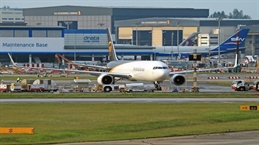
The airline industry is projected to lose over US$11 billion in 2025 due to sluggish aircraft production, according to a new study by the International Air Transport Association (IATA) in collaboration with management consulting company, Oliver Wyman.
In their joint study, Reviving the Commercial Aircraft Supply Chain, the report noted that challenges within the aerospace industry's supply chain are delaying production of new aircraft and parts, resulting in airlines reevaluating their fleet plans and, in many cases, keeping older aircraft flying for extended amounts of time.
The worldwide commercial backlog reached a historic high of more than 17,000 aircraft in 2024, significantly higher than the 2010 to 2019 backlog of around 13,000 aircraft per year.
The estimated loss is driven by delays in new deliveries, forcing carriers to rely on older, less fuel-efficient planes, driving fuel-related losses to US$4.2 billion.
The aging fleet is also pushing maintenance costs up by US$3.1 billion, as older aircraft demand more frequent and costly upkeep. Meanwhile, engine leasing expenses have climbed by US$2.6 billion, with longer maintenance cycles keeping engines grounded and lease rates reportedly up by as much as 20% since 2019.
To buffer against erratic supply chains, airlines are stockpiling spare parts—adding another US$1.4 billion in surplus inventory costs. Together, these pressures reflect a compounding financial strain tied directly to production bottlenecks and deferred fleet renewal.
In addition to the mounting costs, supply chain challenges inhibit airlines from deploying sufficient aircraft to meet growing passenger demand. In 2024, passenger demand rose 10.4%, exceeding the capacity expansion of 8.7% and pushing load factors to a record 83.5%. The trend in rising passenger demand continues into 2025.
The current aerospace industry economic model, disruptions from geopolitical instability, raw material shortages and tight labor markets all contribute to the origin of the matter.
With these underlying causes considered, the report outlines key initiatives for original equipment manufacturers (OEMs), lessors, and suppliers supported by airlines to confront the supply-demand imbalance and build greater resilience.
"Airlines depend on a reliable supply chain to operate and grow their fleets efficiently. Now we have unprecedented waits for aircraft, engines and parts and unpredictable delivery schedules. Together these have sent costs spiralling by at least US$11 billion for this year and limited the ability of airlines to meet consumer demand," said Willie Walsh, director-general at IATA.
He added that there is "no simple solution" to resolving this problem, but there are several actions that could provide some relief.
"To start, opening the aftermarket would help by giving airlines greater choice and access to parts and services. In parallel, greater transparency on the state of the supply chain would give airlines the data they need to plan around blockages while helping OEMs to ease underlying bottlenecks," Walsh said.
The aerospace industry could also consider opening up aftermarket best practices by supporting Maintenance, Repair and Operations (MRO) to be less dependent on OEM-driven commercial licensing models, as well as facilitating access to alternative sourcing of materials and services.
They could also enhance supply chain visibility by creating clearer visibility across all supplier levels to spot risks early, reduce bottlenecks and inefficiencies, and use better data and tools to make the whole chain more resilient and reliable; and unlock value from data by leveraging predictive maintenance insights, pooling spare parts, and creating shared maintenance data platforms to optimize inventory and reduce downtime.
The industry could also expand repair and parts capacity to accelerate repair approvals, support alternative parts and Used Serviceable Material (USM) solutions, and adopt advanced manufacturing to ease bottlenecks.
"To enact any of these initiatives, the first and most critical step for commercial aerospace industry participants to take is to develop a strategic approach among all stakeholders in the supply chain," IATA said in a statement.
"The multi-headed challenges facing the industry call for collaboration to progress in the goal of better meeting aircraft production and maintenance demand," it added.



